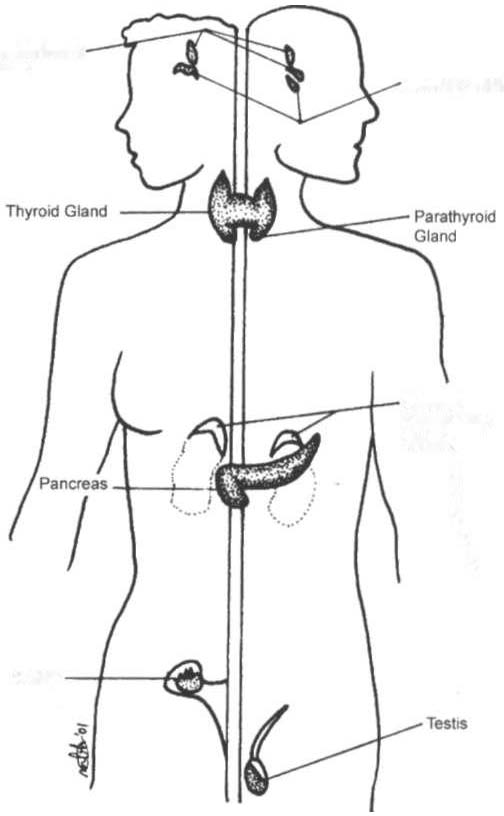i bc27f85be50b71b1 (202 page)
Read i bc27f85be50b71b1 Online
Authors: Unknown

areas. The following areas may be affected:
• Tongue
• Heart
• Gastrointestinal tract
• Liver
• Spleen
• Kidney
• Peripheral nerves
• Pancreas
• Cerebral vessels
•
Skin
In general, the deposition of protein in these areas will result in
firmer, less distensible tissues that compromise organ function.
Management of amyloidosis consisrs of controlling any primary disease process that may promote deposition of amyloid into the tissues.l.s

648 AClJfE CARE HANDBOOK FOR I'HYSICAL THERAPISrS
References
1. Bullock BL. Pathophysiology: Adaprarions and Alrerarions in Funcrion
(4th cd). Philadelphia: Lippincott, 1996.
2. Kimberly RP. Research advances in systemic lupus erythemarosus.
JAMA 2001;285(5):650.
3. McConnell EA. Abour sysremic lupus erythemarosus. Nursing 1999;
29(9):26.
4. Wallace OJ. Updare on managing lupus erythemarosus. J Musculoskeletal Med 1999;16(9):531.
5. Chandrasoma P, Taylor CR. Concise Pathology (2nd ed). East Norwalk,
CT: Appleton & Lange, ·'995.
6. Morey 55. American Thoracic Society issues consensus statement on
sarcoidosis. Am Fam Physician 2000;61 (2):553.
7. Johns CJ, Michele TM. The clinical management of sarcoidosis a 50-
year experience ar the Johns Hopkins Hospiral. Medicine 1999;
78(2):65.
8. Goodman ec, Snyder TEK. Differential Diagnosis in Physical Therapy:
Musculoskeleral and Systemic Conditions. Philadelphia: Saunders,
1 995.

11
Endocrine System
Jaime C. Paz
lntroduction
The endocrine system consists of endocrine glands, which secrete
hormones into the bloodstream, and target cells for those hormones. Target cells are the principal sites of action for the endocrine glands. Figure 11-1 displays the location of the primary endocrine glands.
The endocrine system has direct effects on cellular function and
metabolism throughout the entire body, with symptoms of endocrine,
metabolic dysfunction, or both often mimicking those of muscle
fatigue. Also, the onset of clinical manifestations from endocrine or
metabolic dysfunction, or both, can often be insidious and subtle in
presentation. Therefore, it is important for the physical therapist to
carefully distinguish the source (endocrine versus musculoskeletal) of
these symptoms to optimally care for the patient. For example, complaints of weakness and muscle cramps can result from hypothyroidism or inappropriate exercise intensity. If the therapist is aware of the patient'S current endocrine system status, then inquiring about a
recent medication adjustment may be more appropriate than adjusting the patiem's exercise parameters.
649


650
AClJn� CARE HANDBOOK FOR PHYSICAL THERAPISTS
Hypothalamic
Nudei
PItuitary Gland
Adrenal
(Iuprarenal)
Glandl \
0,,,..,
Figure 11-1. Schematic representatiol1 of the primary endocrine glands in
women a"d me". (Figure redraw" by Marybeth Cuaycong.)
The objectives of this chapter are ro provide a basic understanding
of the following:
1. Normal functions of the endocrine system, including the thyroid,
pituitary, adrenal, and parathyroid glands, as well as the pancreas
2. Clinical evaluation of these endocrine organs
3 . Endocrine system dysfunction and subsequent medical management
4. Physical therapy guidelines for working with patients who
have endocrine system dysfunction

ENDOCRINE SYSTEM
65]
Screening for Metabolic and Endocrine Dysfunction
The following quesrions help ro provide a systemaric method ro differentiate the patient's symptoms and complaints to a specific endocrine gland. Full integrarion of the parienr's signs and symptoms with laborarory dara by the physician is, however, necessary ro accurately
diagnose the disorder. Physical therapists can use these questions to
help guide their evaluations and organize inquiries for the medical
team regarding treatment parameters. For instance, if the questions
lead the therapist to suspect pituitary involvement, seeking clarification from the physician regarding the appropriateness of physical therapy intervention may be necessary. I
I. Piruitary
a. Are menses regular? (If they are irregular, hypopituitarism
may be suspected.)
b. Has rhere been a change in vision? (Large piruitary tumors
can result in vision loss.)
2. Adrenal
a. Is rhere skin darkening? (Chronic primary adrenal insufficiency results in hyperpigmentation.)
b. Is there weight loss, nausea, vomiting, or syncope? (These
are suggestive of adrenal insufficiency.)
c. Have there been episodes of tachycardia, headaches, and
sweating? (These are suggestive of pheochromocytoma.)
3. Thyroid
a. Is there a change in the patient'S neck size? (This can indicate the presence of goiter or hyperthyroidism.)
b. What is the room-remperature preference of the patient?
(60°F suggests hyperthyroidism, whereas 80°F suggests
hypothyroidism.)
4. Parathyroid
a. Is there a history of thyroid surgery? (This is the usual
cause of hypoparathyroidism.)
b. Are kidney stones, polyuria, and constipation present?
(This could indicate hypercalcemia from hypoparathyroidism.)


652 AClfTE CARE. HANDBOOK FOR PHYSICAL THERAPISTS
5. Pancreas
a. Is there nocturia or nocridipsia (urination or drinking at
night, respectively)? (Soth of these can suggest diabetes mellitus.)
b. Has there been a weight loss or gain and increased appetite? (These also suggest diabetes.)
General Evaluation of Endocrine Function
Measurement of endocrine function can be performed by examining
(1) the endocrine gland itself, using imaging techniques, or (2) levels
of hormones or hormone-related substances in the bloodstream or
urine. When reviewing the medical record, it is important for the
physical therapist to know that high or low levels of endocrine substances can indicate endocrine dysfunction. A common method for assessing levels of hormone is radioimmunoassay (RIA).2 RIA is an
immunologic technique for comparing levels of radiolabeled hormone wirh unlabeled hormone, which compete for binding sites on a given antibody.
Another method of evaluarion, referred to as provocative testing, can be classified into suppcession or stimulation tests. Stimulation tests are used for testing endocrine hypofunction; suppressio1l tests are useful in evaluating endocrine hyperfunctionJ The most
